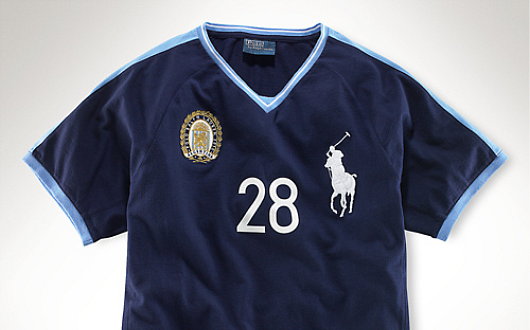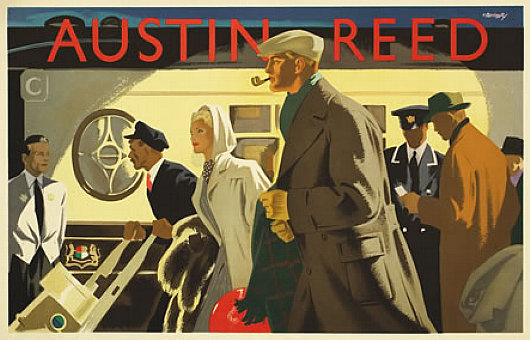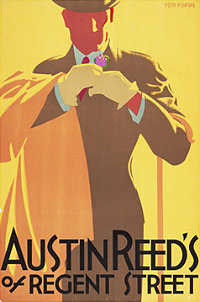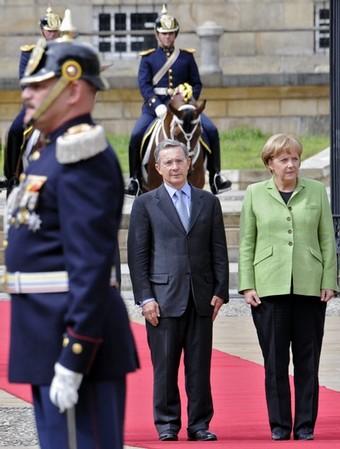Fashion
About Andrew Cusack
 Writer, web designer, etc.; born in New York; educated in Argentina, Scotland, and South Africa; now based in London.
Writer, web designer, etc.; born in New York; educated in Argentina, Scotland, and South Africa; now based in London. read more
News
Blogs
Reviews & Periodicals
Arts & Design
World
France
Mitteleuropa
Knickerbockers
Argentina
The Levant
Africa
Cape of Good Hope
Netherlands
Scandinavia
Québec
India
Muscovy
Germany
Academica
Heraldic Discrepancies in Fashion
Ralph Lauren’s Modern Field Collection

THERE IS ATTENTION to detail and then there is pedantry, and I hope this falls into the former rather than the latter. Among the numerous e-mails which find their way into my electronic postbox are occasional notifications from the Polo Ralph Lauren corporation, a multi-faceted operation involved in the design, sale, and distribution of fairly decent items of clothing. Just one such e-mail received just the other day informed me of Ralph Lauren’s new ‘Modern Field Collection’, yet another judicious tie-in to take advantageous of the patriotic (or vicariously patriotic) impulses of the consumer before, during, and after the 2010 World Cup. As someone who is interested in national and cultural symbolism, most especially heraldry, I was mildly intrigued and clicked through to find a veritable gold mine of discrepancies which I hope the reader will forgive my exposition of. (more…)
Austin Reed

 The London mens’ clothier Austin Reed was founded in 1900 and set up shop in Regent Street in 1926 as the first men’s department store. The clothes were aimed at the upper middle class male, and the firm commissioned some of the best illustrator-designers of the day to promote its brand. The above poster, “Wagon-Lits”, is by a designer named Bomarry, about whom I can find absolutely nothing — surprising in this Age of Google.
The London mens’ clothier Austin Reed was founded in 1900 and set up shop in Regent Street in 1926 as the first men’s department store. The clothes were aimed at the upper middle class male, and the firm commissioned some of the best illustrator-designers of the day to promote its brand. The above poster, “Wagon-Lits”, is by a designer named Bomarry, about whom I can find absolutely nothing — surprising in this Age of Google.
The remaining posters presented here are from the Bristol-born Tom Purvis, one of the finest commercial artists of the twentieth century. Purvis came from an artistic family, being the son of the sailor & nautical artist T. G. Purvis. Much of his output was work for LNER — the London & North Eastern Railway — producing posters advertising the various attractions to be found along the LNER’s routes from London to Edinburgh (via York & Newcastle) and on to Aberdeen and Inverness; the railway also had an extensive coverage of East Anglia. In 1936 he was among the first to be given the title of Royal Designer for Industry, but he gave up poster design after the Second World War to concentrate on portraits and religious themes. (more…)
Monocled Monarch is the King of Fashion
Put Taft on a raft and forget Mr. Vorster: In terms of well-dressed heads of state, the King of Tonga is one of the last of his breed

 It’s an easily observable fact that, in terms of public attire, the heads of state of today generally leave much to be desired, yet the newly crowned King of Tonga (seen right) keeps up the sartorial tradition, not only of his ancestors, but of ours. George Tupou V (or Siaosi Taufa’ahau Manumataongo Tuku’aho Tupou V to give his full name) was crowned just a few weeks ago in a splendid ceremony in Nuku’alofa, the capital of “the Friendly Islands”.
It’s an easily observable fact that, in terms of public attire, the heads of state of today generally leave much to be desired, yet the newly crowned King of Tonga (seen right) keeps up the sartorial tradition, not only of his ancestors, but of ours. George Tupou V (or Siaosi Taufa’ahau Manumataongo Tuku’aho Tupou V to give his full name) was crowned just a few weeks ago in a splendid ceremony in Nuku’alofa, the capital of “the Friendly Islands”.
Though Tonga is certainly not the only monarchy in the Pacific — Japan, Australia, and New Zealand are the most prominent — it is one of the smallest and certainly one of the most traditional. So traditional, in fact, that it is on the naughty list of the CIA-linked “Freedom House” foundation. Tonga’s crime? That only a minority of the members of Tonga’s parliament, the Fale Alea, are directly elected. Of the 30 members, 9 are elected by a general electorate, 9 are elected by the nobility, 10 are members of the Privy Council, and 2 are governors appointed by the King. Curiously, Freedom House does not treat the United Kingdom the same as Tonga, despite the majority of parliamentarians being either directly appointed by the Crown or elected by hereditary lords — elected MPs consist of less than half of parliament.
Amidst pickelhaubes resplendent

The Chancellor of Germany is seen here worriedly admiring the pickelhaubed cavalry on her state visit to Colombia. Such elements of tradition, widespread in South America, are unofficially but totally banned in Germany.
The almighty loden coat
 Judging by the evidence (yours truly, left, in Connecticut late last fall*), I quite agree with the fellow who wrote in The Field this month:
Judging by the evidence (yours truly, left, in Connecticut late last fall*), I quite agree with the fellow who wrote in The Field this month:
Straw Boaters
 The other evening whilst out on the town with Will Moller (Groton ’02, Kenyon ’06), I was pleased to learn that Groton still graduates its male student in straw boaters.
The other evening whilst out on the town with Will Moller (Groton ’02, Kenyon ’06), I was pleased to learn that Groton still graduates its male student in straw boaters.
I think straw boaters are about due for a revival. And not those horrific plastic numbers that proliferate around convention and campaign time. The real deal. The trouble is the best place to start a straw boater revival is St Andrews, and we’re only all in St Andrews when straw boaters aren’t really “in season” as the sartorialists would say.
Search
Instagram: @andcusack
Click here for my Instagram photos.Most Recent Posts
- Gellner’s Prague December 19, 2024
- Monsieur Bayrou December 18, 2024
- Dempsey Heiner, Art Critic December 17, 2024
- Vote AR December 16, 2024
- Articles of Note: 12 December 2024 December 12, 2024
Most Recent Comments
Book Wishlist
Monthly Archives
Categories



